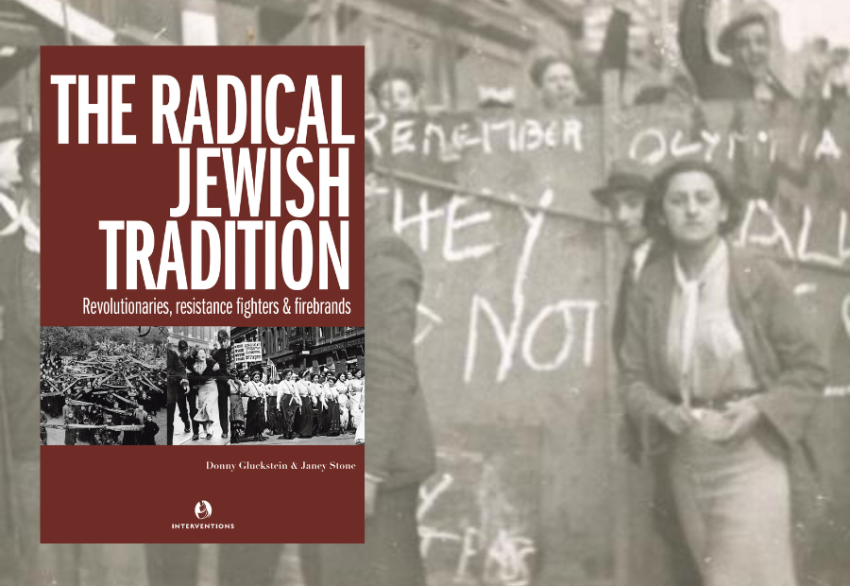
The Radical Jewish Tradition: Revolutionaries, resistance fighters and firebrands
By Donny Gluckstein and Janey Stone
Melbourne: Intervention Books, 2023
385pp
From the late 19th century the leaders of the Zionist movement have argued that no matter where Jews reside they will never be able to fight antisemitism and therefore need a state of their own. This argument is used to justify the Israeli state’s ongoing colonisation, dispossession and genocide of the Palestinian people.
Theodor Herzl, founder of the modern Zionist movement, argued in his 1896 pamphlet, The Jewish State: “The Jewish Question exists wherever Jews live in perceptible numbers. Where it does not exist, it is carried by Jews in the course. We naturally move to those places where we are not persecuted, and there our presence produces persecution. This is the case in every country.”
This belief is echoed in antisemitic arguments about Jewish people being “incompatible” with non-Jews.
In contrast, Janey Stone and Donny Gluckstein’s 2023 book, The Radical Jewish Tradition: Revolutionaries, resistance and Firebrands, uncovers the hidden history of Jewish radicalism and solidarity between Jewish and non-Jewish communities.
The Radical Jewish Tradition traces the roots of modern antisemitism from the medieval period to today. While Jews gained emancipation throughout the capitalist world following the French Revolution, antisemitism remained — along with other forms of discrimination — a useful tool of the ruling class.
In the Russian Empire the Tsarist regime imposed a Pale of Settlement (a defined territory on the Polish-Russian border where Jews were permitted to settle) in 1772 and anti-Jewish discrimination was rife.
In Western Europe, Britain and the United States, antisemitic attitudes and ideas remained widespread. Britain’s 1905 Aliens Act — driven through with the support of Prime Minister Arthur Balfour, author of the 1917 Balfour Declaration — was aimed at restricting Jewish immigration from Russia and Eastern Europe.
Glockstein and Stone show how Zionists remained a small minority in Jewish communities up until World War II. Assimilationist and conservative orthodoxy were the main opponents of radical left wing Jewish activists. Institutions such as the Jewish Board of Deputies play a similarly conservative role within Jewish communities today.
The Radical Jewish Tradition traces the radical currents that emerged in the Tsarist Empire, London’s East End, New York City and Poland from 1881, when the first antisemitic pogroms occurred.
From the start, working-class and radical Jews played a significant role in strikes, defending their communities against pogroms and played a crucial role in the 1905 and 1917 Russian revolutions.
From the 1880s up to 1914, in London’s East End and in Manhattan New York’s Lower East Side, Jewish radicals were active in socialist and anarchist movements, rent strikes and union organising — most notably the 1909‒10 shirtwaist-makers strike in New York and the 1912 Tailors and Dockers Strikes in London.
There are notable examples of vital solidarity between Jewish and Non-Jewish communities. Striking workers conducted meetings in Italian and reached out to Black workers in the 1909 shirtwaist-makers strike. Jewish socialists also played a key role in the formation of US civil rights organisation, the National Association for the Advancement of Colored People (NAACP).
Jewish anarchist Rudolf Rocker played a crucial role in ensuring Jewish tailors came out on strike in solidarity with non-Jewish tailors in London in 1912, organising 8000 strikers and ensuring the strike’s success.
During the 1912 London dockers’ strike, Jewish tailors took in three hundred dockers’ children into their homes, an act of solidarity that historian William Fishman said “laid the foundations of many friendships that neither time nor circumstances could erase”.
Inspired by the 1917 Russian Revolution the Jewish radical tradition continued in Britain, the US and Poland throughout the interwar period. This took the form of strikes, unemployed organising, the growth of Communist parties and the fight against the rising fascist movement. This included the 1936 Battle of Cable Street against British fascist MP Oswald Mosley’s Blackshirts and the 1939 counter-protest against the pro-Nazi German Bund in New York.
The more conservative Jewish and Zionist institutions, such as the Jewish Board of Deputies, were hostile to the working-class radical Jews protesting fascism and advised their communities to ignore these protests. It is also notable that in the face of growing Nazi oppression in the 1930s, Zionist organisations refused to lobby Western governments to admit more Jewish refugees.
In Nazi-occupied Europe, there were plenty of examples of Jewish resistance and solidarity between non-Jews, Communists, liberals, members of the Jewish Labour Bund and even so-called “left Zionists”, who fought as partisans and staged the 1943 Warsaw ghetto uprising.
In Poland, more than 6000 non-Jews were later bestowed with the title “Righteous Among the Nations” by the Yad Vashem Holocaust centre, for risking their lives to protect Jews. Tragically in the interwar period, the “left” Zionists played a key role in undermining any solidarity with Palestinian-Arab workers and formed the Histadrut — a Zionist trade union federation — in 1920 and engaged in class collaboration.
These “left” Zionist originations would play a key role in the formation of the Israeli state in 1948, participating in the dispossession, colonisation and genocide of Indigenous Palestinians — which continues today in Israel’s genocidal war on Gaza.
Anti-Zionist Jews, including the late Marek Edelman, a Warsaw Ghetto survivor, have continued to stand in solidarity with the Palestinian people. The Radical Jewish Tradition brings to life a history that shows that Jewish radicals can forge and find solidarity with other oppressed people, vital for the struggle for a better world.